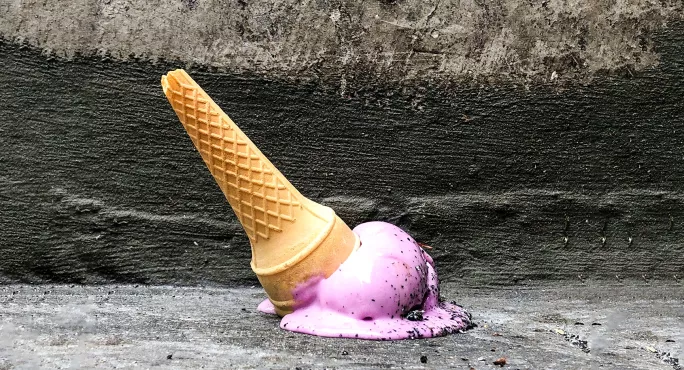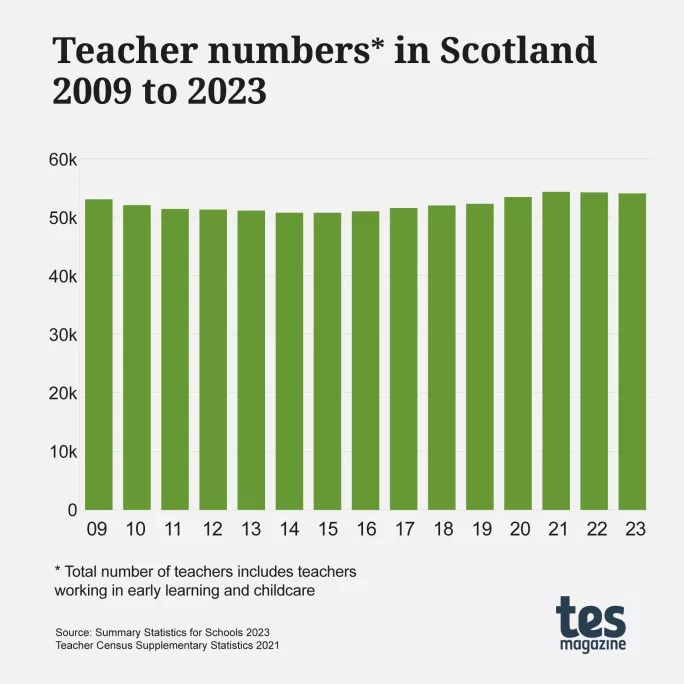Teacher numbers fall in Scotland

Teacher numbers have fallen despite the Scottish government’s pledge to increase teacher numbers by 3,500 over the course of the 2021-26 Parliament.
The fall is the second drop in teacher numbers in a row.
This year there are 54,033 teachers working in Scotland across all sectors, including the early years. This was down 160 on the 2022 total of 54,193 teachers.
Last year overall teacher numbers fell by 92 - the first drop in teacher numbers since 2015.

Financial penalties
The figures will be a significant blow to the Scottish government, which has said it is investing £145.5 million this year to maintain increased teacher numbers and support staff.
After last year’s fall the government warned that, in the future, local authorities would have to maintain teacher numbers or suffer financial penalties.
However, despite the government’s vow to monitor the situation more closely this year after being taken by surprise by last year’s drop - and also to withhold or recoup funding from councils shedding teachers - there has been a fall in 17 of Scotland’s 32 council areas.
- Background: Teacher numbers fall despite Scottish government pledge
- News: Teacher numbers commitment harming other services, MSPs told
- Long read: Why getting teacher recruitment right is proving so difficult
Rise in secondary, fall in primary
The figures show that the number of teachers employed in secondary schools rose by 175 compared to 2022, while the number centrally employed by councils also rose, by 73.
However, there were falls in the number of teachers in primary (down 354 on 2022), in special schools (down 22 on 2022) and in nurseries (down 32 on 2022).
The national pupil-teacher ratio did not change from 2022, remaining at 13.2.
Meanwhile, the proportion of Teacher Induction Scheme probationers that secured a (permanent or temporary) teaching post in a Scottish school in the year following their probation increased slightly to 71 per cent in 2022-23 from 70 per cent for the 2021-22 cohort. This follows the drop last year from 80 to 70 per cent.
However, just 17 per cent of new primary teachers who completed their probation in the school year 2022-23 had found a permanent post in a state school by September. That is down from 20 per cent last year.
In secondary, the proportion of new teachers finding permanent full-time or part-time posts by September of this year also fell. Of those who carried out their probation in 2022-23, 47 per cent had a permanent post by September, down from 50 per cent in September 2022.
EIS teaching union general secretary Andrea Bradley described the teacher number figures as a “wake-up call” for national and local government.
She said: “We need many more teachers to reduce class sizes to enhance the learning experience for all, to provide better support for the even greater number of young people with additional learning needs than last year’s data showed, to help overcome the worrying and growing violence challenges in our schools, and to reduce crippling teacher workload and excessive class-contact time in line with existing Scottish government commitments.”
Ms Bradley highlighted the new EIS campaign Stand up for Quality Education campaign, which calls for more funding and resources for schools. She said that if investment in education is not increased in next week’s Budget, “our young people will continue to pay the price now and our whole society will go on paying the price of the government’s under-investment in education for decades to come”.
Education secretary Jenny Gilruth said: “For the last two years, we have provided local authorities with £145.5 million of annual funding for the purpose of maintaining additional teachers and classroom assistants - this marked the biggest increase to support teacher recruitment since 2007.
“It is therefore disappointing to see that teacher numbers have decreased slightly. I have written to [local authorities’ body] Cosla today to express my disappointment at this decline.
“My officials will be writing directly to those councils which have not maintained teacher numbers in line with the 2022 census to seek further information on the circumstances behind these reductions.”
Ms Gilruth added: “I have been clear with councils that if teacher numbers were not maintained nationally in line with 2022 census figures, the Scottish government may withhold or recoup funding which has been given for this purpose, subject to any mitigating circumstances councils may wish to present.
“It is important to note however that Scotland’s pupil-teacher ratio has remained at 13.2 - which is the lowest figure in the UK.”
A host of education data was published by the Scottish government today, including figures on school attendance rates and the Achievement of Curriculum for Excellence levels, which looks at the attainment in literacy and numeracy.
You need a Tes subscription to read this article
Subscribe now to read this article and get other subscriber-only content:
- Unlimited access to all Tes magazine content
- Exclusive subscriber-only stories
- Award-winning email newsletters
Already a subscriber? Log in
You need a subscription to read this article
Subscribe now to read this article and get other subscriber-only content, including:
- Unlimited access to all Tes magazine content
- Exclusive subscriber-only stories
- Award-winning email newsletters
topics in this article



